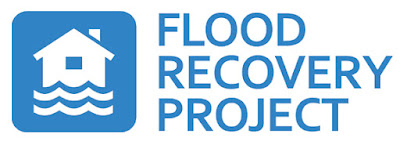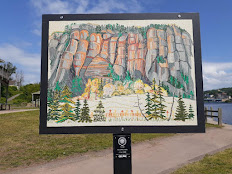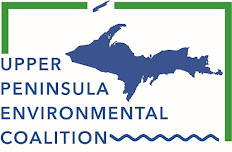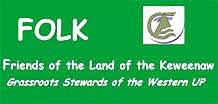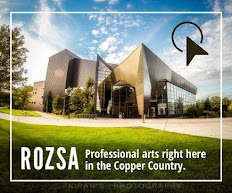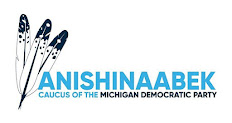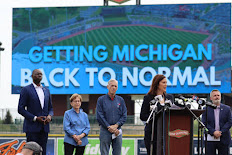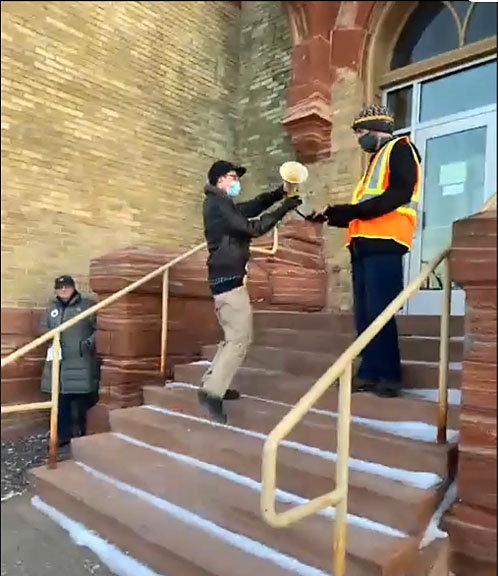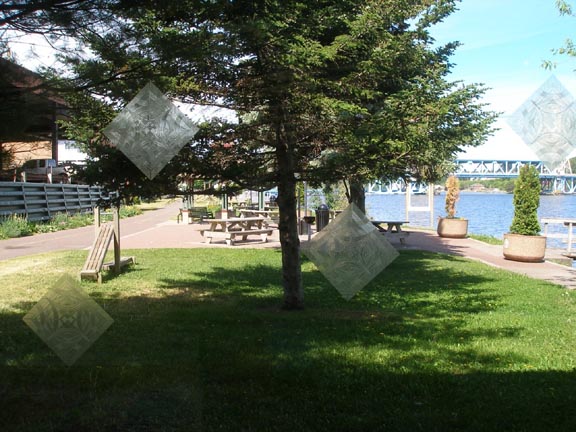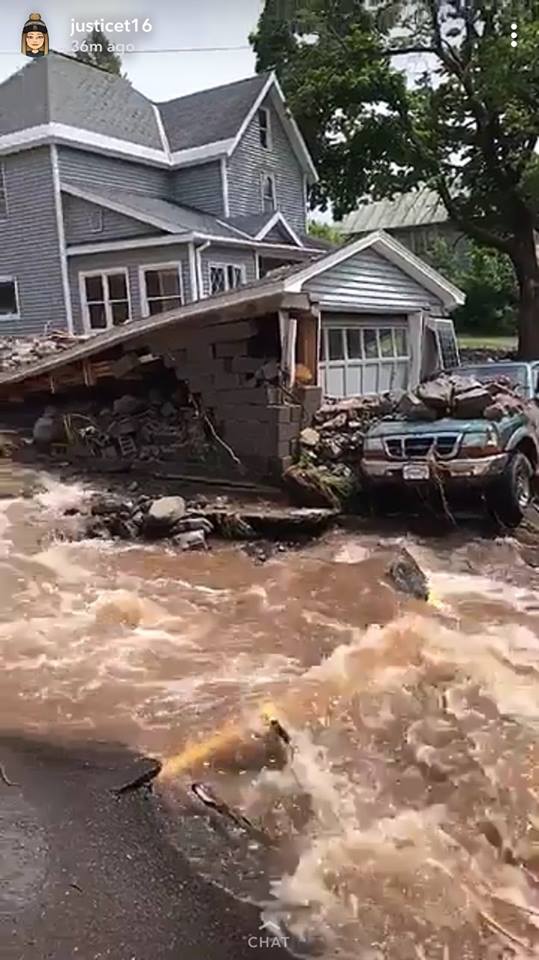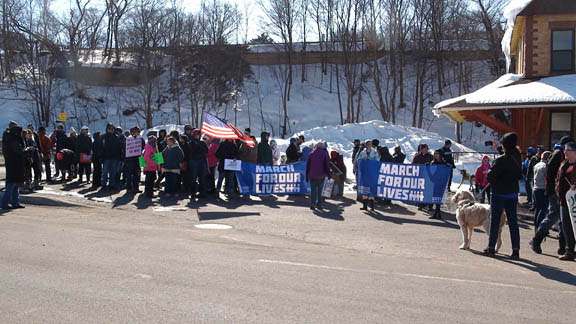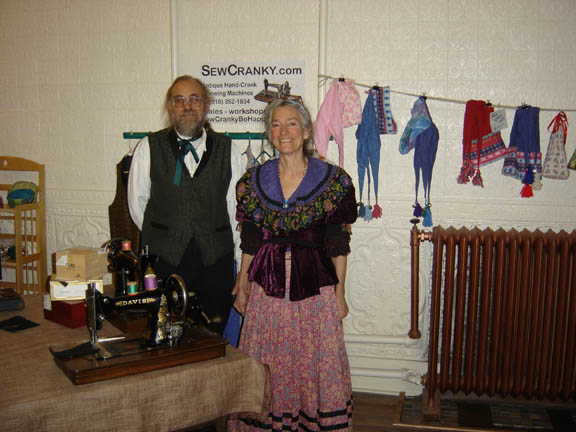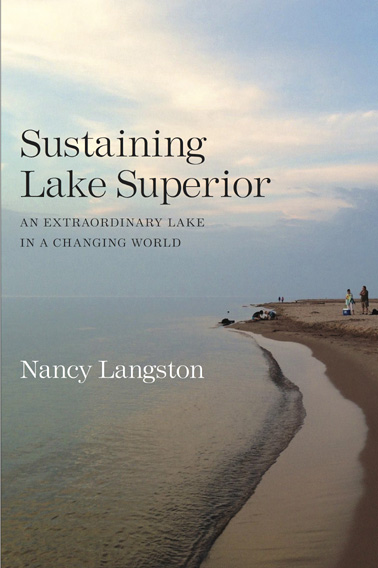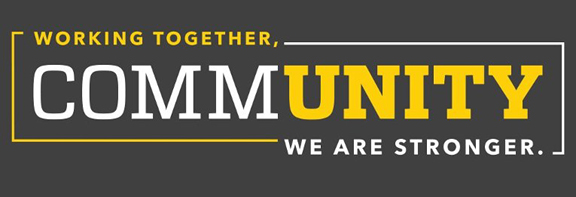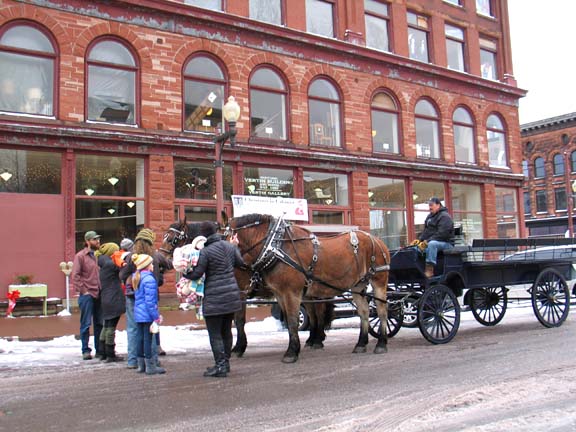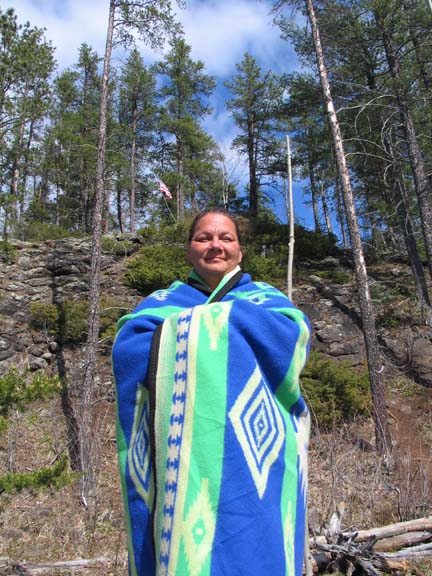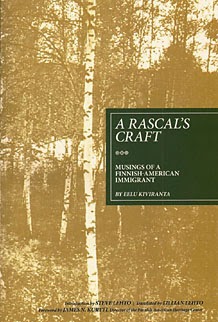A view of the Mackinac Bridge, crossing the Straits of Mackinac. Enbridge's 65-year-old Line 5 pipeline, which lies under the Straits, is destined to be replaced by a multi-use utility tunnel, according to a Dec. 19, 2018, agreement between the State of Michigan and Enbridge. (Keweenaw Now file photo)
From: Michigan Department of Natural Resources (DNR) Bulletin
ST. IGNACE, Mich. -- The Mackinac Straits Corridor Authority (MSCA) approved on Dec. 19, 2018, an agreement with Enbridge Energy Limited Partnership to build a multi-use utility tunnel beneath the Straits of Mackinac. The tunnel will house a replacement segment for the Line 5 pipeline that sits on the bottom of the Straits and other utilities.
In addition, the authority, which held its inaugural meeting in St. Ignace, approved the transfer of a property right that will allow Enbridge to construct the tunnel in bedrock beneath the Straits.
Gov. Rick Snyder and leaders of the departments of Natural Resources and Environmental Quality signed a separate agreement with Enbridge on Dec. 19. This Third Agreement carries forward provisions of two previous agreements with the company -- one in November 2017 and one in October 2018. The Third Agreement requires Enbridge to undertake an enhanced inspection and stewardship regimen. The agreement also includes interpretations of the 1953 easement for the dual pipelines on the bottom of the Straits, as well as ongoing financial assurance requirements for the pipelines.
The Line 5 pipelines would be removed from the bottom of the Straits once the tunnel is complete. The construction could take 7-10 years.
Visit the Michigan Petroleum Pipelines Web site to download these Dec. 19 agreements.
Click here to read the rest of this bulletin from the Michigan DNR.
See also the Dec. 20, 2018, updated article on mlive.com: "Gov. Snyder finalizes Line 5 tunnel deal."
See the recent post from Enbridge here.
Saturday, December 22, 2018
Tuesday, December 18, 2018
Environmental, tribal groups oppose Enbridge-State agreement to construct tunnel in Mackinac Straits; 5-day comment period ends Dec. 18
By Michele Bourdieu
LANSING, HOUGHTON -- On Thursday, Dec. 13, the State of Michigan released for public review and comment proposed agreements related to a planned multi-use utility tunnel in the Straits of Mackinac and the remaining life of Line 5 in the Straits. The documents are posted to the mipetroleumpipelines.com website. Public comment is being accepted through Tuesday, Dec. 18, and supplied to Gov. Rick Snyder, state departments and the Mackinac Straits Corridor Authority (MSCA) for consideration.*
Environmental groups are speaking out against this comment period of a mere 5 days following the legislature's hasty passing (during their lame-duck session) of outgoing Michigan Senator Tom Casperson's bill, SB 1197, for constructing a tunnel under the Straits of Mackinac to "protect" the aging Line 5 pipeline.
Last week that bill was passed on Dec. 11, and on Dec. 12 outgoing Governor Snyder signed it into Public Act 359. This law directs the MSCA to enter into an agreement with Enbridge Energy Corporation -- the company that owns and operates Line 5 -- for construction of the utility tunnel, provided the agreement meets certain conditions. Under the proposed agreement, Enbridge would pay for all design, construction, operation and maintenance costs for the tunnel. The law establishes a separate Straits Protection Fund to pay for the work of the MSCA, including independent experts to ensure proper construction and operation of the tunnel.
On Dec. 12, immediately after Gov. Snyder's signing PA 359, the Michigan League of Conservation Voters (Michigan LCV) issued this statement:
"After widespread opposition from Michigan citizens, businesses, experts and more, a backroom deal brokered by special interest groups to keep oil flowing through our Great Lakes was hastily jammed through the Legislature in the 11th hour," said Lisa Wozniak, executive director at Michigan LCV. "We are deeply disappointed Gov. Snyder approved legislation that will keep oil pumping through the damaged Line 5 Pipeline for another decade or more."
Wozniak added, "On Nov. 6, the people of Michigan made their position clear by electing candidates who pledged to keep oil pipelines out of our Great Lakes and protect our drinking water. We will continue to advocate, communicate and fight to protect our water and oppose oil pipelines in the Great Lakes as the new administration takes office."
On Dec. 15, the Upper Peninsula Environmental Coalition (UPEC) addressed comments on the Proposed Tunnel Agreement between MSCA and Enbridge Energy to the Michigan Department of Natural Resources (DNR) and the Pipeline Safety Advisory Board.
"The public notice for the Proposed Agreement was posted at 3:03 p.m. on December 13, 2018, with the public period ending on December 18, 2018, for a period of just over five days, including a weekend," UPEC states. "Such a limited public comment period for a proposal of this magnitude, presented in a legally dense document, with such significant potential impacts to the population of the State and beyond is an egregious abuse of power, and an obvious attempt to limit public review and input. The State should extend the public comment period for 60 days to allow adequate time for public review and comment. The manner in which this Proposed Agreement is being pushed through also ties the hands of the incoming Governor, and is an affront to Michigan voters and the democratic process."
UPEC also points out that a federal permit should be required for a project such as this tunnel under the Great Lakes.
"The U.S. Army Corps of Engineers has jurisdiction to require a permit for the proposed tunnel under the Straits, a federally designated navigable water, pursuant to Section 10 of the Rivers and Harbors Act of 1899," UPEC says. "The Agreement should explicitly reference that authority and the fact that a federal permit would need to be obtained for the construction and operation of the proposed tunnel. That federal permit review process would involve an opportunity for agency, private group, and public review and comment, as well as analysis under the National Environmental Policy Act, to potentially include preparation of an Environmental Impact Statement."
UPEC also challenges Article 11 on Indemnification, which states, "Enbridge will defend, indemnify, protect and hold harmless the Authority and the State of Michigan, and all of its officers, officials, agents, and employees, each in their capacities as such (Indemnitee) from and against (a) any Claim or Liability arising out of or in connection with the work done by Enbridge or its contractors under this Agreement, including without limitation, the design, construction, operation and maintenance of the Tunnel or the Line 5 Straits Replacement Segment, and (b) any Claim or Liability relating to the Tunnel arising out of or in connection with the condition of state-owned lands beneath the Straits of Mackinac."
UPEC notes that "if the Authority, and by extension, the State is the lease holder and/or permittee or co-permittee of the Tunnel, an indemnity agreement cannot shield the State against an enforcement action of a federal permitting authority due to a catastrophic failure of Line 5, including a major spill of liquid hydrocarbon product into the Straits or other portions of the Great Lakes and its shorelines."
UPEC concludes, "The manner in which this Agreement and accompanying documents is being rushed through at the end of the Snyder Administration gives the undeniable impression that there is not a sincere desire to provide the public with a reasonable opportunity to be informed of the State’s and Enbridge’s intentions with respect to the Tunnel, nor to allow for a deliberative process that considers the potential impacts to the incomparable natural resources of the Straits of Mackinac and the Great Lakes ecosystem. This is especially true in consideration of Enbridge’s dismal track record of major pipeline spills, including in Michigan. This Agreement and the entire subject of the construction of a Tunnel under the Straits of Mackinac should be left to the incoming Whitmer Administration, in accordance with the clear expression of the voters of Michigan."**
Another environmental group, which has been calling for decommissioning Line 5 because of the danger of such a major oil spill, is Oil and Water Don't Mix.
Mary Pelton Cooper of Marquette, left, is pictured here with June Thaden of Traverse City at the 2017 Pipe Out Paddle protest against Line 5 in Mackinaw City. Both support the activist organization Oil and Water Don't Mix, which has been calling for the shutdown of Line 5 since 2013. (Keweenaw Now file photo)
Oil and Water Don't Mix has asked concerned citizens to sign, on their Web site, a new petition against the construction of this tunnel, saying, "There is no light at the end of Gov. Snyder’s proposed Line 5 oil pipeline tunnel under the Straits of Mackinac. Michigan doesn’t need Enbridge’s Line 5 or the oil it sends to southern Ontario. We don’t need to keep the Great Lakes at risk of a catastrophic oil pipeline rupture in the Straits while state officials spend years and taxpayer resources keeping an old oil pipeline running so a Canadian oil transport company can get a new pipeline built in Michigan to transport heavy tar sands oil. What we do need is a clear timetable to close Line 5 under the Straits of Mackinac and keep oil pipelines out of the Great Lakes!"
Their petition lists several objections to the tunnel (cited here in part):
-- Exposing Great Lakes to tar sands oil. "Line 5 does not currently transport heavy tar sands oil thanks to the State of Michigan’s 2015 ban. However, a new Canadian tunnel in the Straits is an invitation for Enbridge to seek to lift this ban and transport tar sands in Line 5."
-- Continuing to use the 65-year-old Line 5. "Since 1968, Line 5 has ruptured at least 29 times on land, spilling over 1.1 million gallons of oil into Michigan’s pristine lands and waters. Line 5 traverses 245 other water crossings, including ones that are tributaries of Lakes Michigan, Superior, and Huron. One Line 5 spill in the Upper Peninsula near Lake Michigan contaminated 825 tons of soil in the Hiawatha National Forest and exposed groundwater to potential contamination."
-- Ignoring the law and alternatives. "A Canadian tunnel under the Straits is not permissible under Michigan’s Great Lakes Submerged Lands Act (GLSLA), common law public trust doctrine, and would risk violating the 1836 Treaty and consent decree with Michigan Tribes protecting the Straits fishing grounds."
-- Opposing the public’s will, Michigan's 2002 directional oil and gas drilling ban. "Strongly supported by the public, the 2002 drilling ban was designed to prevent the very risk a Line 5 tunnel for Canada would present. In addition, May 2018 public polling results found 54 percent of Michigan voters want the Line 5 oil pipeline in the Straits of Mackinac to be shut down, and 87 percent of voters said they are concerned that the 65-year-old pipeline could have an oil spill in Northern Michigan, while 64 percent said they are 'very concerned.'"
-- Harming the Michigan economy, from tourism to fishing, during tunnel construction.
-- Promoting climate change by continued investment in fossil fuel infrastructure.***
Tribal Groups: Tunnel plan ignores treaty fishing rights
According to Nov. 2, 2018, article in Michigan's Bridge magazine, tribal groups complain that the Line 5 Tunnel ignores fishing rights guaranteed to them by an 1836 Treaty.
"While the Snyder administration formally met with tribes three times over the past year under a State-Tribal Accord, tribal leaders say these consultations were little more than an 'airing of grievances' for them," the article notes.
A jiiman (tribal canoe) participates in the Sept. 3, 2016, Pipe Out Paddle protest against Line 5 near the Mackinac Bridge. (Keweenaw Now file photo © and courtesy Miguel Levy)
"The last meeting between tribes and Gov. Rick Snyder was Sept. 27, less than a week before the state announced an agreement with Enbridge to pursue a $500 million tunnel for the company’s Line 5 pipeline. In other meetings, officials have been unwilling to share information from Enbridge or modify any agreements, tribes say."****
Jannan J. Cornstalk, citizen of the Little Traverse Bay Bands (LTBB) of Odawa Indians and organizer of the September 2016 Pipe Out Paddle Protest against Line 5, commented to Keweenaw Now this week on the importance of protecting the water.
"Our water is in a state of emergency on so many levels," she said. "From PFAs (per- and polyfluoroalkyl substances) to Flint and other areas around the world. We need water to live and I wish people would live their lives as if this knowledge were true. Water is sacred. As Anishinaabek we choose to co-exist with it and hope to have clean healthy water for generations. Shut down Line 5 before it's too late!"
During the 2016 Pipe Out Paddle protest, organizer Jannan Cornstalk, right, is pictured here with her daughter, Jannan Cotto, near the Mackinac Bridge. Both are from Petoskey, Mich., and citizens of the Little Traverse Bay Bands of Odawa Indians (LTBB). Cotto is also LTBB education director. (Keweenaw Now file photo)
Professor Martin Reinhardt of the Center for Native American Studies at Northern Michigan University also organized and participated in the protests against Line 5 at the Mackinac Bridge and offered these comments to Keweenaw Now:
"I have serious concerns about how Line 5 has impacted our responsibility, as Anishinaabe people, to protect our Mother earth and our fellow inhabitants. The United States has a legal and political obligation to protect our Aboriginal rights, and to uphold our treaty rights which guarantee our continued ability to hunt, fish, and gather as well as the other usual privileges of occupancy. I am also a citizen of the United States, and a US Army veteran. I believe that the US has great potential to help save our planet from the very serious threat of global warming, if we and other nations work together with traditional Indigenous knowledge holders to begin reversing the damage that we have inflicted through our continued reliance on petroleum products. Lastly, the people of the State of Michigan have a duty to stand up and stop this madness. We literally have a foreign company telling the Governor of our State to leave a dangerous oil pipeline in waters that are in desperate need of protection. So much for Pure Michigan! Shame on Governor Snyder and his cronies for jeopardizing the health of future generations."
Professor Martin Reinhardt of Northern Michigan University, second from right seated and drumming, joins drummers and singers during the 2017 Pipe Out Paddle protest against Line 5 near the Mackinac Bridge. (Keweenaw Now file photo)
The Anishinaabek have set up a camp for all Water Protectors -- a place to gather in unity and solidarity with all Anishinaabek, to live in balance and harmony, to build a positive place to rest. They are opposed to the Line 5 attack on the Great Lakes and offer cultural classes. The camp is located at 2716 Reed Rd., Levering, MI 49755.****
Michigan Tech and Enbridge
Meanwhile, Michigan Technological University researchers, faculty and students have contributed their technological expertise to assist Enbridge by monitoring the lake environment in the Straits with one of their scientific buoys; directing a team of 41 experts to produce a worst-case-scenario, independent risk analysis on Line 5; and offering to both government and industry a preliminary, student-created design for the tunnel.
In August 2015 Michigan Tech's environmental monitoring buoy for the Straits of Mackinac was successfully deployed west of the Mackinac Bridge. The buoy uses sonar to measure the flow of the water beneath the buoy. It also measures wind direction and speed, wind gust speed, air temperature, relative humidity, barometric pressure, solar radiation, water temperature, wave height and direction.*****
Michigan Tech's monitoring buoy near the Mackinac Bridge. (File photo courtesy Guy Meadows, Great Lakes Research Center director)
During the past year, Michigan Tech's Guy Meadows, director of the Great Lakes Research Center (GLRC) led a team of 41 researchers -- 21 from Michigan Tech and 20 from other organizations and universities -- who conducted an independent risk analysis of the two aging Line 5 pipelines under the Straits in order to determine the potential environmental and economic impacts of a potential oil spill in the Straits. The draft report was submitted last July, and the final report, the "Independent Risk Analysis for the Straits Pipelines," was published on Sept. 15, 2018.
This Figure ES4 from the Executive Summary of the "Independent Risk Analysis for the Straits Pipelines," based on modeling, shows the Maximum Extent of Shoreline Oiling predicted for the Straits of Mackinac and Lake Michigan and Huron Regions as Associated with the Meteorological, Ice Cover and Water Current Conditions Observed for January. Results depicted above represent a total oiled shoreline distance of 1146 km following an oil release date and time of 01/17/2016 at 1800 hrs from the northern pipeline release point and a total dispersal simulation time of 60 days. The red particles represent dispersed oil.******
On Friday, Dec. 14, the Michigan Tech Board of Trustees heard a presentation on a senior design project for an underwater utility corridor spanning the Straits of Mackinac. Michael Prast, Michigan Tech graduate student in civil engineering, who had presented the project to Michigan legislators and policymakers in Lansing last May, described the project to the Michigan Tech trustees. Here he talks about three of the four teams of students contributing to the projeect:
Michigan Tech graduate student Michael Prast describes, to the Michigan Tech Board of Trustees, several aspects of the senior design project for designing a tunnel under the Straits of Mackinac. Click on YouTube icon to watch video with larger screen. (Videos by Keweenaw Now)
This slide from the student presentation displays the students' design concept of the potential tunnel under the Straits. Click here and then on Mackinac Straits Tunnel Presentation to view the slides of the Power Point presentation. (Photo by Keweenaw Now)
Here Prast recounts his experiences presenting the project to officials in Lansing:
Prast updates the trustees on recent proposals (for the tunnel plans) by Gov. Snyder and Enbridge and describes reactions to the students'
presentations in Lansing. Click on YouTube icon for larger screen.
Prast concludes his presentation and welcomes questions. Click on YouTube icon for larger screen.
Horst Schmidt, UPEC president, who attended the student presentation at the Board of Trustees meeting, said he thought Michael Prast's presentation was well done.
"However, the magnitude of the project is not just one of engineering," Schmidt added. "That he (Prast) admitted there are no recent studies of the geology of the Straits is disturbing. The law itself ignores many state and federal regulations. That Enbridge is given the authority to build the line with its poor record of compliance is unbelievable. Even the outgoing DEQ (Department of Environmental Quality) director has commented in the past upon not being able to trust the company. And as has happened in other recent legislation, the governor is hastily approving these laws before he leaves office."
Guy Meadows, GLRC director, who attended the presentation at the Board of Trustees meeting, had a positive reaction to the student project.
"They did a wonderful job," he said. "It's great to see how creative they were in their thinking and to have such a positive response from the State and Enbridge."
Meadows said the tunnel is not covered in his final "worst-case-scenario" risk analysis report (mentioned above).
"We received a positive response to the report from the general public and the State," he noted.
As for the tunnel, he said, "I think it's certainly a step forward."
Now that the risk analysis report is complete, Meadows said Michigan Tech is working on setting up High Frequency Radar (HFR) to monitor surface currents throughout the Straits all year round and 24/7. This will provide more monitoring since the environmental buoys are taken out of the water in the winter.
"This will be the first operational HFR in the State," he noted.
Notes:
* On Wednesday, Dec. 19, 2018, the new Mackinac Straits Corridor Authority will hold its inaugural meeting from 1 p.m. to 3 p.m. at the Little Bear Arena, 275 Marquette St., St. Ignace. The three-member authority is charged with overseeing construction and operation of a proposed multi-use utility tunnel beneath the Straits of Mackinac. The tunnel will house a replacement segment for the dual Line 5 petroleum pipeline in the Straits, and reportedly will be built to accommodate other utilities.
** Learn more about UPEC by visiting their Web site.
UPDATE: Click here for their Dec. 15, 2018, proposed letter on the tunnel agreement.
*** Click here to read the entire petition and sign it.
**** See "Michigan tribes say Line 5 pipeline tunnel plan ignores treaty rights."
UPDATE: See the Dec. 14, 2018, Washington Post article on the Anishinaabek camp for water protectors, "A submerged oil pipeline triggers a winter of frigid protest."
***** See our Sept. 13, 2015, article, "Michigan Tech/Enbridge buoy deployed in Mackinac Straits; Gov. Snyder visits GLRC."
****** Click here for the Executive Summary of the final report, "Independent Risk Analysis for the Straits Pipelines."
Today, Tuesday, Dec. 18, is the last day to submit comments (during a 5-day comment period) on proposed agreements related to a planned utility tunnel in the Straits of Mackinac. Construction of the tunnel could take 10 years while the aging Line 5 pipelines would remain under the Straits. Email or call in your comments as indicated above. (Photo courtesy Anishinaabek Camp - Shutdown Line 5 Facebook page)
LANSING, HOUGHTON -- On Thursday, Dec. 13, the State of Michigan released for public review and comment proposed agreements related to a planned multi-use utility tunnel in the Straits of Mackinac and the remaining life of Line 5 in the Straits. The documents are posted to the mipetroleumpipelines.com website. Public comment is being accepted through Tuesday, Dec. 18, and supplied to Gov. Rick Snyder, state departments and the Mackinac Straits Corridor Authority (MSCA) for consideration.*
Environmental groups are speaking out against this comment period of a mere 5 days following the legislature's hasty passing (during their lame-duck session) of outgoing Michigan Senator Tom Casperson's bill, SB 1197, for constructing a tunnel under the Straits of Mackinac to "protect" the aging Line 5 pipeline.
Last week that bill was passed on Dec. 11, and on Dec. 12 outgoing Governor Snyder signed it into Public Act 359. This law directs the MSCA to enter into an agreement with Enbridge Energy Corporation -- the company that owns and operates Line 5 -- for construction of the utility tunnel, provided the agreement meets certain conditions. Under the proposed agreement, Enbridge would pay for all design, construction, operation and maintenance costs for the tunnel. The law establishes a separate Straits Protection Fund to pay for the work of the MSCA, including independent experts to ensure proper construction and operation of the tunnel.
On Dec. 12, immediately after Gov. Snyder's signing PA 359, the Michigan League of Conservation Voters (Michigan LCV) issued this statement:
"After widespread opposition from Michigan citizens, businesses, experts and more, a backroom deal brokered by special interest groups to keep oil flowing through our Great Lakes was hastily jammed through the Legislature in the 11th hour," said Lisa Wozniak, executive director at Michigan LCV. "We are deeply disappointed Gov. Snyder approved legislation that will keep oil pumping through the damaged Line 5 Pipeline for another decade or more."
Wozniak added, "On Nov. 6, the people of Michigan made their position clear by electing candidates who pledged to keep oil pipelines out of our Great Lakes and protect our drinking water. We will continue to advocate, communicate and fight to protect our water and oppose oil pipelines in the Great Lakes as the new administration takes office."
On Dec. 15, the Upper Peninsula Environmental Coalition (UPEC) addressed comments on the Proposed Tunnel Agreement between MSCA and Enbridge Energy to the Michigan Department of Natural Resources (DNR) and the Pipeline Safety Advisory Board.
"The public notice for the Proposed Agreement was posted at 3:03 p.m. on December 13, 2018, with the public period ending on December 18, 2018, for a period of just over five days, including a weekend," UPEC states. "Such a limited public comment period for a proposal of this magnitude, presented in a legally dense document, with such significant potential impacts to the population of the State and beyond is an egregious abuse of power, and an obvious attempt to limit public review and input. The State should extend the public comment period for 60 days to allow adequate time for public review and comment. The manner in which this Proposed Agreement is being pushed through also ties the hands of the incoming Governor, and is an affront to Michigan voters and the democratic process."
UPEC also points out that a federal permit should be required for a project such as this tunnel under the Great Lakes.
"The U.S. Army Corps of Engineers has jurisdiction to require a permit for the proposed tunnel under the Straits, a federally designated navigable water, pursuant to Section 10 of the Rivers and Harbors Act of 1899," UPEC says. "The Agreement should explicitly reference that authority and the fact that a federal permit would need to be obtained for the construction and operation of the proposed tunnel. That federal permit review process would involve an opportunity for agency, private group, and public review and comment, as well as analysis under the National Environmental Policy Act, to potentially include preparation of an Environmental Impact Statement."
UPEC also challenges Article 11 on Indemnification, which states, "Enbridge will defend, indemnify, protect and hold harmless the Authority and the State of Michigan, and all of its officers, officials, agents, and employees, each in their capacities as such (Indemnitee) from and against (a) any Claim or Liability arising out of or in connection with the work done by Enbridge or its contractors under this Agreement, including without limitation, the design, construction, operation and maintenance of the Tunnel or the Line 5 Straits Replacement Segment, and (b) any Claim or Liability relating to the Tunnel arising out of or in connection with the condition of state-owned lands beneath the Straits of Mackinac."
UPEC notes that "if the Authority, and by extension, the State is the lease holder and/or permittee or co-permittee of the Tunnel, an indemnity agreement cannot shield the State against an enforcement action of a federal permitting authority due to a catastrophic failure of Line 5, including a major spill of liquid hydrocarbon product into the Straits or other portions of the Great Lakes and its shorelines."
UPEC concludes, "The manner in which this Agreement and accompanying documents is being rushed through at the end of the Snyder Administration gives the undeniable impression that there is not a sincere desire to provide the public with a reasonable opportunity to be informed of the State’s and Enbridge’s intentions with respect to the Tunnel, nor to allow for a deliberative process that considers the potential impacts to the incomparable natural resources of the Straits of Mackinac and the Great Lakes ecosystem. This is especially true in consideration of Enbridge’s dismal track record of major pipeline spills, including in Michigan. This Agreement and the entire subject of the construction of a Tunnel under the Straits of Mackinac should be left to the incoming Whitmer Administration, in accordance with the clear expression of the voters of Michigan."**
Another environmental group, which has been calling for decommissioning Line 5 because of the danger of such a major oil spill, is Oil and Water Don't Mix.
Mary Pelton Cooper of Marquette, left, is pictured here with June Thaden of Traverse City at the 2017 Pipe Out Paddle protest against Line 5 in Mackinaw City. Both support the activist organization Oil and Water Don't Mix, which has been calling for the shutdown of Line 5 since 2013. (Keweenaw Now file photo)
Oil and Water Don't Mix has asked concerned citizens to sign, on their Web site, a new petition against the construction of this tunnel, saying, "There is no light at the end of Gov. Snyder’s proposed Line 5 oil pipeline tunnel under the Straits of Mackinac. Michigan doesn’t need Enbridge’s Line 5 or the oil it sends to southern Ontario. We don’t need to keep the Great Lakes at risk of a catastrophic oil pipeline rupture in the Straits while state officials spend years and taxpayer resources keeping an old oil pipeline running so a Canadian oil transport company can get a new pipeline built in Michigan to transport heavy tar sands oil. What we do need is a clear timetable to close Line 5 under the Straits of Mackinac and keep oil pipelines out of the Great Lakes!"
Their petition lists several objections to the tunnel (cited here in part):
-- Exposing Great Lakes to tar sands oil. "Line 5 does not currently transport heavy tar sands oil thanks to the State of Michigan’s 2015 ban. However, a new Canadian tunnel in the Straits is an invitation for Enbridge to seek to lift this ban and transport tar sands in Line 5."
-- Continuing to use the 65-year-old Line 5. "Since 1968, Line 5 has ruptured at least 29 times on land, spilling over 1.1 million gallons of oil into Michigan’s pristine lands and waters. Line 5 traverses 245 other water crossings, including ones that are tributaries of Lakes Michigan, Superior, and Huron. One Line 5 spill in the Upper Peninsula near Lake Michigan contaminated 825 tons of soil in the Hiawatha National Forest and exposed groundwater to potential contamination."
-- Ignoring the law and alternatives. "A Canadian tunnel under the Straits is not permissible under Michigan’s Great Lakes Submerged Lands Act (GLSLA), common law public trust doctrine, and would risk violating the 1836 Treaty and consent decree with Michigan Tribes protecting the Straits fishing grounds."
-- Opposing the public’s will, Michigan's 2002 directional oil and gas drilling ban. "Strongly supported by the public, the 2002 drilling ban was designed to prevent the very risk a Line 5 tunnel for Canada would present. In addition, May 2018 public polling results found 54 percent of Michigan voters want the Line 5 oil pipeline in the Straits of Mackinac to be shut down, and 87 percent of voters said they are concerned that the 65-year-old pipeline could have an oil spill in Northern Michigan, while 64 percent said they are 'very concerned.'"
-- Harming the Michigan economy, from tourism to fishing, during tunnel construction.
-- Promoting climate change by continued investment in fossil fuel infrastructure.***
Tribal Groups: Tunnel plan ignores treaty fishing rights
According to Nov. 2, 2018, article in Michigan's Bridge magazine, tribal groups complain that the Line 5 Tunnel ignores fishing rights guaranteed to them by an 1836 Treaty.
"While the Snyder administration formally met with tribes three times over the past year under a State-Tribal Accord, tribal leaders say these consultations were little more than an 'airing of grievances' for them," the article notes.
A jiiman (tribal canoe) participates in the Sept. 3, 2016, Pipe Out Paddle protest against Line 5 near the Mackinac Bridge. (Keweenaw Now file photo © and courtesy Miguel Levy)
"The last meeting between tribes and Gov. Rick Snyder was Sept. 27, less than a week before the state announced an agreement with Enbridge to pursue a $500 million tunnel for the company’s Line 5 pipeline. In other meetings, officials have been unwilling to share information from Enbridge or modify any agreements, tribes say."****
Jannan J. Cornstalk, citizen of the Little Traverse Bay Bands (LTBB) of Odawa Indians and organizer of the September 2016 Pipe Out Paddle Protest against Line 5, commented to Keweenaw Now this week on the importance of protecting the water.
"Our water is in a state of emergency on so many levels," she said. "From PFAs (per- and polyfluoroalkyl substances) to Flint and other areas around the world. We need water to live and I wish people would live their lives as if this knowledge were true. Water is sacred. As Anishinaabek we choose to co-exist with it and hope to have clean healthy water for generations. Shut down Line 5 before it's too late!"
During the 2016 Pipe Out Paddle protest, organizer Jannan Cornstalk, right, is pictured here with her daughter, Jannan Cotto, near the Mackinac Bridge. Both are from Petoskey, Mich., and citizens of the Little Traverse Bay Bands of Odawa Indians (LTBB). Cotto is also LTBB education director. (Keweenaw Now file photo)
Professor Martin Reinhardt of the Center for Native American Studies at Northern Michigan University also organized and participated in the protests against Line 5 at the Mackinac Bridge and offered these comments to Keweenaw Now:
"I have serious concerns about how Line 5 has impacted our responsibility, as Anishinaabe people, to protect our Mother earth and our fellow inhabitants. The United States has a legal and political obligation to protect our Aboriginal rights, and to uphold our treaty rights which guarantee our continued ability to hunt, fish, and gather as well as the other usual privileges of occupancy. I am also a citizen of the United States, and a US Army veteran. I believe that the US has great potential to help save our planet from the very serious threat of global warming, if we and other nations work together with traditional Indigenous knowledge holders to begin reversing the damage that we have inflicted through our continued reliance on petroleum products. Lastly, the people of the State of Michigan have a duty to stand up and stop this madness. We literally have a foreign company telling the Governor of our State to leave a dangerous oil pipeline in waters that are in desperate need of protection. So much for Pure Michigan! Shame on Governor Snyder and his cronies for jeopardizing the health of future generations."
Professor Martin Reinhardt of Northern Michigan University, second from right seated and drumming, joins drummers and singers during the 2017 Pipe Out Paddle protest against Line 5 near the Mackinac Bridge. (Keweenaw Now file photo)
The Anishinaabek have set up a camp for all Water Protectors -- a place to gather in unity and solidarity with all Anishinaabek, to live in balance and harmony, to build a positive place to rest. They are opposed to the Line 5 attack on the Great Lakes and offer cultural classes. The camp is located at 2716 Reed Rd., Levering, MI 49755.****
Michigan Tech and Enbridge
In August 2015 Michigan Tech's environmental monitoring buoy for the Straits of Mackinac was successfully deployed west of the Mackinac Bridge. The buoy uses sonar to measure the flow of the water beneath the buoy. It also measures wind direction and speed, wind gust speed, air temperature, relative humidity, barometric pressure, solar radiation, water temperature, wave height and direction.*****
Michigan Tech's monitoring buoy near the Mackinac Bridge. (File photo courtesy Guy Meadows, Great Lakes Research Center director)
During the past year, Michigan Tech's Guy Meadows, director of the Great Lakes Research Center (GLRC) led a team of 41 researchers -- 21 from Michigan Tech and 20 from other organizations and universities -- who conducted an independent risk analysis of the two aging Line 5 pipelines under the Straits in order to determine the potential environmental and economic impacts of a potential oil spill in the Straits. The draft report was submitted last July, and the final report, the "Independent Risk Analysis for the Straits Pipelines," was published on Sept. 15, 2018.
This Figure ES4 from the Executive Summary of the "Independent Risk Analysis for the Straits Pipelines," based on modeling, shows the Maximum Extent of Shoreline Oiling predicted for the Straits of Mackinac and Lake Michigan and Huron Regions as Associated with the Meteorological, Ice Cover and Water Current Conditions Observed for January. Results depicted above represent a total oiled shoreline distance of 1146 km following an oil release date and time of 01/17/2016 at 1800 hrs from the northern pipeline release point and a total dispersal simulation time of 60 days. The red particles represent dispersed oil.******
On Friday, Dec. 14, the Michigan Tech Board of Trustees heard a presentation on a senior design project for an underwater utility corridor spanning the Straits of Mackinac. Michael Prast, Michigan Tech graduate student in civil engineering, who had presented the project to Michigan legislators and policymakers in Lansing last May, described the project to the Michigan Tech trustees. Here he talks about three of the four teams of students contributing to the projeect:
This slide from the student presentation displays the students' design concept of the potential tunnel under the Straits. Click here and then on Mackinac Straits Tunnel Presentation to view the slides of the Power Point presentation. (Photo by Keweenaw Now)
Here Prast recounts his experiences presenting the project to officials in Lansing:
Horst Schmidt, UPEC president, who attended the student presentation at the Board of Trustees meeting, said he thought Michael Prast's presentation was well done.
"However, the magnitude of the project is not just one of engineering," Schmidt added. "That he (Prast) admitted there are no recent studies of the geology of the Straits is disturbing. The law itself ignores many state and federal regulations. That Enbridge is given the authority to build the line with its poor record of compliance is unbelievable. Even the outgoing DEQ (Department of Environmental Quality) director has commented in the past upon not being able to trust the company. And as has happened in other recent legislation, the governor is hastily approving these laws before he leaves office."
Guy Meadows, GLRC director, who attended the presentation at the Board of Trustees meeting, had a positive reaction to the student project.
"They did a wonderful job," he said. "It's great to see how creative they were in their thinking and to have such a positive response from the State and Enbridge."
Meadows said the tunnel is not covered in his final "worst-case-scenario" risk analysis report (mentioned above).
"We received a positive response to the report from the general public and the State," he noted.
As for the tunnel, he said, "I think it's certainly a step forward."
Now that the risk analysis report is complete, Meadows said Michigan Tech is working on setting up High Frequency Radar (HFR) to monitor surface currents throughout the Straits all year round and 24/7. This will provide more monitoring since the environmental buoys are taken out of the water in the winter.
"This will be the first operational HFR in the State," he noted.
Notes:
* On Wednesday, Dec. 19, 2018, the new Mackinac Straits Corridor Authority will hold its inaugural meeting from 1 p.m. to 3 p.m. at the Little Bear Arena, 275 Marquette St., St. Ignace. The three-member authority is charged with overseeing construction and operation of a proposed multi-use utility tunnel beneath the Straits of Mackinac. The tunnel will house a replacement segment for the dual Line 5 petroleum pipeline in the Straits, and reportedly will be built to accommodate other utilities.
** Learn more about UPEC by visiting their Web site.
UPDATE: Click here for their Dec. 15, 2018, proposed letter on the tunnel agreement.
*** Click here to read the entire petition and sign it.
**** See "Michigan tribes say Line 5 pipeline tunnel plan ignores treaty rights."
UPDATE: See the Dec. 14, 2018, Washington Post article on the Anishinaabek camp for water protectors, "A submerged oil pipeline triggers a winter of frigid protest."
***** See our Sept. 13, 2015, article, "Michigan Tech/Enbridge buoy deployed in Mackinac Straits; Gov. Snyder visits GLRC."
****** Click here for the Executive Summary of the final report, "Independent Risk Analysis for the Straits Pipelines."
Thursday, December 13, 2018
Lame-duck power grabs by Michigan's Republican-controlled legislature undermine voters' will; proposed bills may be unconstitutional
How pure is our State of Michigan when our legislators attempt to undermine the will of the people? (Image courtesy Michigan Department of Natural Resources)
By Michele Bourdieu
LANSING -- Millions of Michiganders voted to pass Proposal 2 on the November 2018 ballot by an overwhelming margin, thus amending the Michigan Constitution to move redistricting out of the Legislature and to an Independent Citizens Redistricting Commission that will redraw the congressional district lines every 10 years. Proposal 2, started by the group Voters Not Politicians, intends to end gerrymandering in Michigan.
Gerrymandering is dividing a state, county, etc., into election districts so as to give one political party a majority in many districts while concentrating the voting strength of the other party into as few districts as possible. It gives one party an unfair political advantage.
Despite the passing of Proposal 2, the lame duck session of the Michigan legislature has allowed the Republicans to propose bills that would undermine the will of the voters as expressed in the November 2018 election. One of these is Senate Bill 1254, which is described as "a bill to provide for certain duties of the secretary of state relating to the independent citizens redistricting commission; to provide for certain rules and procedures governing the application and selection process for commissioners; to prescribe standards for establishing political party affiliation; to prohibit individuals affiliated with a political party from providing services to the commission; to provide civil sanctions; and to provide for the powers and duties of certain state and local governmental officers and entities."
According to Voters Not Politicians, Senate Bill 1254 is unconstitutional, unnecessary, and unethical. It directly undermines the self-executing redistricting reform amendment (Proposal 2 on the ballot) that was overwhelmingly supported by 61 percent of Michigan voters. Senate Bill 1254 is unnecessary because the constitutional amendment does not need or even allow involvement from the Legislature. Senate Bill 1254 is unethical because it undermines the will of the voters.*
According to Michigan's Bridge magazine SB 1254 is only one of several bills being proposed in this lame duck session that would make major changes affecting Michigan’s government, environment and more.**
On Dec. 11 outgoing Michigan Senator Tom Casperson's bill, SB 1197 for constructing a tunnel under the Straits of Mackinac to "protect" the aging Line 5 pipeline was passed and on Dec. 12 outgoing Governor Snyder signed it into law as Public Act 359 of 2018, despite the fact that Governor-elect Gretchen Whitmer and Attorney General-elect Dana Nessel have opposed the tunnel plan and called for decommissioning Line 5.
Another of Sen. Casperson's anti-environment bills, SB 1211, "would carve out a slew of exemptions to state permitting requirements for property owners wanting to fill, dredge or build upon wetlands and lakes," according to the Bridge.**
A Dec. 5, 2018, Bridge article on Sen. Casperson states, "Casperson, who is term-limited, is behind a slew of bills that would loosen state environmental regulations in favor of industry, developers and other private property owners. The efforts include opening more wetlands and lakes to unregulated development, allowing landfills to accept more low-level radioactive waste and preempting local control over tree cutting and removal."***
House Bill 6595, on validity of signatures on initiative petitions, would amend the Michigan Election Law to set new requirements for signatures collected on initiative petitions and state that failure to comply with them would render the signatures invalid and unable to be counted.
Subjects of other lame-duck proposed bills include marijuana (changing elements of the November ballot's Proposal 1 approved by voters), changes in regulations for toxic chemicals, repeal of Michigan's 10-cent bottle deposit law, minimum wage, sick leave and other power grabs by Republicans in both the Michigan House and the Michigan Senate.**
A Dec. 11, 2018, article in The Guardian, "Courts likely to strike down Republican lame-duck power grabs, experts say," holds some optimism for Democrats' legal challenges to the Republican power grabs in the Michigan legislature.
"In short, some experts see the moves as a dramatic overreach by one branch of government to grab powers in the domain of others: one probably doomed to fail when it is legally challenged," the article states.
The article notes claims by legal experts that these Republican-controlled legislature efforts to limit executive power are unconstitutional.
* Click here to learn more about SB 1254 and how you can contact your state legislators to ask that they vote "NO" on SB 1254.
** Click here to read the Bridge magazine's "Lame Duck Tracker."
*** See the Bridge magazine's article on outgoing Sen. Tom Casperson, "Michigan Republican Senator: I’m no anti-environmental villain."
Editor's Note:
Michigan residents, you can contact Governor Snyder and express your views on these proposed bills by calling (517) 373-3400, (517) 335-7858 (constituent services) or emailing governorsoffice@michigan.gov.
By Michele Bourdieu
LANSING -- Millions of Michiganders voted to pass Proposal 2 on the November 2018 ballot by an overwhelming margin, thus amending the Michigan Constitution to move redistricting out of the Legislature and to an Independent Citizens Redistricting Commission that will redraw the congressional district lines every 10 years. Proposal 2, started by the group Voters Not Politicians, intends to end gerrymandering in Michigan.
Gerrymandering is dividing a state, county, etc., into election districts so as to give one political party a majority in many districts while concentrating the voting strength of the other party into as few districts as possible. It gives one party an unfair political advantage.
Despite the passing of Proposal 2, the lame duck session of the Michigan legislature has allowed the Republicans to propose bills that would undermine the will of the voters as expressed in the November 2018 election. One of these is Senate Bill 1254, which is described as "a bill to provide for certain duties of the secretary of state relating to the independent citizens redistricting commission; to provide for certain rules and procedures governing the application and selection process for commissioners; to prescribe standards for establishing political party affiliation; to prohibit individuals affiliated with a political party from providing services to the commission; to provide civil sanctions; and to provide for the powers and duties of certain state and local governmental officers and entities."
According to Voters Not Politicians, Senate Bill 1254 is unconstitutional, unnecessary, and unethical. It directly undermines the self-executing redistricting reform amendment (Proposal 2 on the ballot) that was overwhelmingly supported by 61 percent of Michigan voters. Senate Bill 1254 is unnecessary because the constitutional amendment does not need or even allow involvement from the Legislature. Senate Bill 1254 is unethical because it undermines the will of the voters.*
According to Michigan's Bridge magazine SB 1254 is only one of several bills being proposed in this lame duck session that would make major changes affecting Michigan’s government, environment and more.**
On Dec. 11 outgoing Michigan Senator Tom Casperson's bill, SB 1197 for constructing a tunnel under the Straits of Mackinac to "protect" the aging Line 5 pipeline was passed and on Dec. 12 outgoing Governor Snyder signed it into law as Public Act 359 of 2018, despite the fact that Governor-elect Gretchen Whitmer and Attorney General-elect Dana Nessel have opposed the tunnel plan and called for decommissioning Line 5.
Another of Sen. Casperson's anti-environment bills, SB 1211, "would carve out a slew of exemptions to state permitting requirements for property owners wanting to fill, dredge or build upon wetlands and lakes," according to the Bridge.**
A Dec. 5, 2018, Bridge article on Sen. Casperson states, "Casperson, who is term-limited, is behind a slew of bills that would loosen state environmental regulations in favor of industry, developers and other private property owners. The efforts include opening more wetlands and lakes to unregulated development, allowing landfills to accept more low-level radioactive waste and preempting local control over tree cutting and removal."***
House Bill 6595, on validity of signatures on initiative petitions, would amend the Michigan Election Law to set new requirements for signatures collected on initiative petitions and state that failure to comply with them would render the signatures invalid and unable to be counted.
Subjects of other lame-duck proposed bills include marijuana (changing elements of the November ballot's Proposal 1 approved by voters), changes in regulations for toxic chemicals, repeal of Michigan's 10-cent bottle deposit law, minimum wage, sick leave and other power grabs by Republicans in both the Michigan House and the Michigan Senate.**
A Dec. 11, 2018, article in The Guardian, "Courts likely to strike down Republican lame-duck power grabs, experts say," holds some optimism for Democrats' legal challenges to the Republican power grabs in the Michigan legislature.
"In short, some experts see the moves as a dramatic overreach by one branch of government to grab powers in the domain of others: one probably doomed to fail when it is legally challenged," the article states.
The article notes claims by legal experts that these Republican-controlled legislature efforts to limit executive power are unconstitutional.
* Click here to learn more about SB 1254 and how you can contact your state legislators to ask that they vote "NO" on SB 1254.
** Click here to read the Bridge magazine's "Lame Duck Tracker."
*** See the Bridge magazine's article on outgoing Sen. Tom Casperson, "Michigan Republican Senator: I’m no anti-environmental villain."
Editor's Note:
Michigan residents, you can contact Governor Snyder and express your views on these proposed bills by calling (517) 373-3400, (517) 335-7858 (constituent services) or emailing governorsoffice@michigan.gov.
Wednesday, December 12, 2018
Rozsa Center to host three holiday concerts -- Dec. 13, 14, 15
Enjoy three different holiday concerts this week at the Rozsa. (Photo courtesy Rozsa Center for the Performing Arts)
HOUGHTON -- Celebrate the holidays with music at the Rozsa! Join the Rozsa Center and the Michigan Tech Department of Visual and Performing Arts for three holiday inspired concerts this week: First, a free Trombone Choir on Thursday, Dec. 13; next, enjoy Gifts of Music, a concert by the Superior Wind Symphony on Friday, Dec. 14; and the Michigan Tech Choirs performing Celebration of Lights on Saturday, Dec. 15. All shows are at 7:30 p.m. at the Rozsa Center for the Performing Arts.
 According to Michael Christianson, director of Bands and conductor of both Trombone Choir and Gifts of Music, "The Trombone Choir concert presents music by the melodious Michigan Tech Trombone Choir in the beautiful Rozsa Lobby and will include a pianist and a vocalist, with other surprises! Then on Friday, The Superior Wind Symphony brings musical gifts that are varied and diverse for you at the end of this year. The Gifts of Music program includes 'The Sussex Mummer’s Christmas Carol' by Percy Grainger and Mike Christianson; 'Three Moods of Hanukkah,' arranged by Lenny Niehaus; two traditional carols, 'Silent Night' and 'O Tannebaum,' co-arranged by Wynton Marsalis; and 'Variations on a Shaker Melody' by Aaron Copland -- among other holiday-inspired songs."
According to Michael Christianson, director of Bands and conductor of both Trombone Choir and Gifts of Music, "The Trombone Choir concert presents music by the melodious Michigan Tech Trombone Choir in the beautiful Rozsa Lobby and will include a pianist and a vocalist, with other surprises! Then on Friday, The Superior Wind Symphony brings musical gifts that are varied and diverse for you at the end of this year. The Gifts of Music program includes 'The Sussex Mummer’s Christmas Carol' by Percy Grainger and Mike Christianson; 'Three Moods of Hanukkah,' arranged by Lenny Niehaus; two traditional carols, 'Silent Night' and 'O Tannebaum,' co-arranged by Wynton Marsalis; and 'Variations on a Shaker Melody' by Aaron Copland -- among other holiday-inspired songs."
Jared Anderson, associate professor of Music and director of Choral Activities at Michigan Tech, describes A Celebration of Lights: "The choirs will sing of light from the menorah, the moon, stars, warm homes, a cradle. We hope that people from across the Keweenaw will take some time to join us for this concert. We are especially looking forward to collaborating with the Copper Country Bells, a local group of handbell players who will join the combined choirs for two numbers on the program."*
Trombone Choir is free. Tickets for Gifts of Music and Celebration of Lights are on sale now: $13 for adults, $5 for youth, and no charge for Michigan Tech students with the Experience Tech fee. Tickets are available by phone at (906) 487-2073, online at mtu.edu/rozsa, in person at the Central Ticketing Office in the Student Development Complex, or the night of the show at the Rozsa box office, which opens two hours prior to performances.
(Inset photos courtesy Rozsa Center)
* Click here and on each event to access a program.
 According to Michael Christianson, director of Bands and conductor of both Trombone Choir and Gifts of Music, "The Trombone Choir concert presents music by the melodious Michigan Tech Trombone Choir in the beautiful Rozsa Lobby and will include a pianist and a vocalist, with other surprises! Then on Friday, The Superior Wind Symphony brings musical gifts that are varied and diverse for you at the end of this year. The Gifts of Music program includes 'The Sussex Mummer’s Christmas Carol' by Percy Grainger and Mike Christianson; 'Three Moods of Hanukkah,' arranged by Lenny Niehaus; two traditional carols, 'Silent Night' and 'O Tannebaum,' co-arranged by Wynton Marsalis; and 'Variations on a Shaker Melody' by Aaron Copland -- among other holiday-inspired songs."
According to Michael Christianson, director of Bands and conductor of both Trombone Choir and Gifts of Music, "The Trombone Choir concert presents music by the melodious Michigan Tech Trombone Choir in the beautiful Rozsa Lobby and will include a pianist and a vocalist, with other surprises! Then on Friday, The Superior Wind Symphony brings musical gifts that are varied and diverse for you at the end of this year. The Gifts of Music program includes 'The Sussex Mummer’s Christmas Carol' by Percy Grainger and Mike Christianson; 'Three Moods of Hanukkah,' arranged by Lenny Niehaus; two traditional carols, 'Silent Night' and 'O Tannebaum,' co-arranged by Wynton Marsalis; and 'Variations on a Shaker Melody' by Aaron Copland -- among other holiday-inspired songs." Jared Anderson, associate professor of Music and director of Choral Activities at Michigan Tech, describes A Celebration of Lights: "The choirs will sing of light from the menorah, the moon, stars, warm homes, a cradle. We hope that people from across the Keweenaw will take some time to join us for this concert. We are especially looking forward to collaborating with the Copper Country Bells, a local group of handbell players who will join the combined choirs for two numbers on the program."*
Trombone Choir is free. Tickets for Gifts of Music and Celebration of Lights are on sale now: $13 for adults, $5 for youth, and no charge for Michigan Tech students with the Experience Tech fee. Tickets are available by phone at (906) 487-2073, online at mtu.edu/rozsa, in person at the Central Ticketing Office in the Student Development Complex, or the night of the show at the Rozsa box office, which opens two hours prior to performances.
(Inset photos courtesy Rozsa Center)
* Click here and on each event to access a program.
Friday, November 30, 2018
Environmental and human health threats from poorly regulated mining in Michigan's UP continue to multiply; DNR to hold meeting on Highland Copper's lease request Dec. 4
[ANNOUNCEMENT: The Michigan Department of Natural Resources’ Office of Minerals Management will hold an informational public meeting on a metallic minerals lease request by UPX Minerals Inc., a division of Highland Copper, from 6 p.m. - 8 p.m. (ET) Tuesday, Dec. 4, in the Charcoal Room at the University Center on the campus of Northern Michigan University in Marquette. DNR officials will give a brief overview of the metallic mineral lease request submitted by UPX Minerals, Inc., and will provide the audience with the opportunity to ask questions. Questions will be answered as time allows. The following article, by Steve Garske, is a slightly updated version of his article that appeared recently in UP Environment, the Fall 2018 newsletter of the Upper Peninsula Environmental Coalition (UPEC). It is published here with permission.]
By Steve Garske*
On May 30, 2017, Highland Copper Company Inc. acquired approximately 447,842 acres (700 square miles) of mineral properties in the central UP (the "UPX Properties") from the Rio Tinto Group. Then this spring Highland/UPX Minerals requested some 3900 acres (over 6.1 square miles) of mineral leases from the state.
Unlike previous lease requests, which targeted primarily state and commercial forest lands, these potential leases include a state natural area (Rocking Chair Lakes), the Noquemanon Trail Network in the Forestville Trailhead area, and the Upper Peninsula Land Conservancy's Vielmetti-Peters Conservation Reserve near Marquette. They also include lakes, wetlands, streams and rivers, camps, homesteads and residential areas. Affected landowners are understandably upset with the possibility of mineral exploration under their lands and even their homes.
Highland's lease request follows on the heels of the Michigan DNR's handing mineral leases for 15,300 acres (23.9 square miles) of mostly public and private forest land in Baraga, Houghton, Iron and Marquette Counties to Eagle Mine/Lundin LLC in 2017. Soon afterwards, Lundin requested a lease for state mineral rights under Haystack Mountain in Houghton County, which the state gladly handed them earlier this year. Haystack Mountain is a unique geologic feature, an ancient 100-foot high "volcanic plug" that straddles Ottawa National Forest and private land.
Except for Highland's lease request, which is still "under consideration," the Michigan DNR has handed over leases to every square inch of mineral rights that mining companies have requested. Why? It certainly can't be the state royalties. As stated by the state's Metallic Minerals Lease Agreement, "Rental for the first (1st) through fifth (5th) year shall be paid at the rate of $3.00 per acre per lease year, and for the sixth (6th) through tenth (10th) year at the rate of $6.00 per acre per lease year." Lease royalties don't kick in until the 11th year, when rates go to $10.00/acre and up. (See https://www.michigan.gov/documents/dnr/PR4340MetallicMineralLease_197342_7.pdf)
Topping off the state's willingness to please the mining industry was the decision by DEQ director Heidi Grether to overrule her professional staff and hand Aquila Resources Inc. a wetland destruction permit for their "Back 40" mine, even though the company's application failed to meet the requirements of state and federal law.
Sixty Islands section of the Menominee River, riparian wetlands located approximately 200 feet from the proposed Project Boundary of the Aquila Back Forty Mine site. (Jan. 9, 2018, photo by Kathleen Heideman, UPEC's Mining Action Group.)
The willingness of the DNR and DEQ to freely hand out exploration and mining permits can be blamed in large part on a phenomenon known as "regulatory capture." Wikipedia (2018) defines regulatory capture as "... a form of government failure which occurs when a regulatory agency, created to act in the public interest, instead advances the commercial or political concerns of special interest groups that dominate the industry or sector it is charged with regulating." A University of Chicago School of Business blogger defines it as "...the tendency of regulators, politicians, and bureaucrats to cater to the interests of special interest groups that are highly informed and not to the interests of the general public" (Rolnik 2017). Regulatory capture can also occur when industry is the only source of technical expertise needed to understand production processes and what might go wrong (Cohen 2018).
Cohen goes on to describe a new form of regulatory capture: the willful rejection of science in setting environmental policy. This form of regulatory capture is based on fantasy and a disregard for expertise. In June Governor Snyder institutionalized regulatory capture in Michigan by passing the "Fox in the Henhouse" bills (Senate Bills 662-654), which let the governor appoint a panel of mostly industry representatives with the power to veto regulations written by the DEQ's environmental and health professionals.
The wild U.P. that many of us know and love is under threat like never before. The government agencies that are supposed to protect it are in large part working for the industries they are supposed to be regulating. It's going to be up to the rest of us to save the wild U.P.
Sources:
Wikipedia. 2018. "Regulatory capture." https://en.wikipedia.org/wiki/Regulatory_capture.
Rolnik, Guy. April 17, 2017. "When We Are Less Interested in the Truth, Capture Thrives." ProMarket: the blog of the Stigler Center at the University of Chicago Booth School of Business. https://promarket.org/less-interested-truth-capture-thrives/.
Cohen, Steve. April 16, 2018. "Scott Pruitt, Andrew Wheeler, and regulatory capture at the EPA." https://blogs.ei.columbia.edu/2018/04/16/pruitt-wheeler-regulatory-capture-epa/.
Editor's Notes:
* Guest author Steve Garske is a botanist and a member of UPEC's Mining Action Group.
** Click here to see detailed maps of the mineral lease requests.
*** See our Feb. 2, 2018, article, "DEQ hearing on Back 40 wetlands permit attracts nearly 500; Menominee Tribe lawsuit seeks federal Clean Water Act jurisdiction."
Thursday, November 29, 2018
"Permission," new exhibit by Finnish American artist Tia Keo, opens Nov. 29 at Finlandia University Gallery
"Permission," an exhibit by Finnish American artist Tia Salmela Keobounpheng, is now on display in the Finlandia University Gallery through Feb. 15, 2019. An opening reception will be held TONIGHT, Nov. 29. (Photos courtesy Finlandia University Gallery)
HANCOCK -- Finlandia University Gallery will present the 28th Annual Contemporary Finnish American Artist Series Exhibition featuring the work of artist Tia Salmela Keobounpheng. Her exhibit, titled "Permission," will be on display at the Finlandia University Gallery, located in the Finnish American Heritage Center, Hancock, from Nov. 29, 2018, to Feb. 15, 2019.
An opening reception for the public will take place at the gallery from 7 p.m. to 8:30 p.m. TONIGHT, Thursday, Nov. 29, with an artist talk beginning at 7:20 p.m. The reception is free and open to the public. Refreshments will be served.
Tia Salmela Keobounpheng (Tia Keo), the 28th Finnish American artist and designer to exhibit in Finlandia University's Annual Contemporary Finnish American Artist Series Exhibition, has spent much of her life exploring the intersection of architecture, design, art and craft. Across disciplines, she creates work that is rooted in the spirit of everyday design principles and organic handcraft of her Finnish heritage.
After ten years of growing as a designer and creative entrepreneur with her Silvercocoon collection of everyday laser-cut acrylic and wood jewelry, she is returning to exploring in art and craft.
"Permission" is a collection of work across mediums that she gave herself the freedom to make -- not tied to marketplace considerations. Hand-woven wall hangings, watercolor and acrylic paintings spurred from her daily painting practice are fodder for her expansion into woven metal sculptures that pull together all of her skills and vision. They are her current, most passionate, permission.
Bosom Bowl no.3, 2018, by Tia Keo. Copper and copper wire.
"My new sculpture work merges metal and weaving. Reliant on the skill of my hands, flat sheets of metal take form and thin fibers of varying materials are repetitively connected to create vessels that are organic and textured, solid and permeable," notes Tia Keo. "These small-scale sculptures started as exploratory exercises and have become symbolic of larger emotional issues I am stewing on. They feel new and also intrinsic. Some reflect my history as a jewelry artist, others are suggestive of the lifelong influence of architecture and design. For the first time in my life, all of my disparate experiences and skills are merging together into one body of work that is tied directly to me claiming my purpose."
Tia’s love of weaving goes back over twenty years and ties her to Finland and to the rich history of women’s work.
"Working with my hands connects ancestral women in my lineage (beyond the grandmothers I never knew) through blood memory and instinctual know-how. Symbolic of the break in tradition, my sculptures allow me to present weaving in an untraditional way; not functional or practical or soft -- but strong with deliberate vulnerability," says Keo.
The artist Tia Salmela Keobounpheng.
Tia’s work also explores how culture, gender, and identity contribute to our internal and external narratives of personal image.
"As a white American woman of Finnish heritage as well as the wife of a Southeast Asian refugee, and the mother of mixed-race children, I am in the unique position to connect to other white Americans as a way to begin working to recognize bias, inspire greater tolerance and to address privilege as it relates to different cultures," says Keo. "Immigrant stories of a hundred years ago relate again and again to the immigrant stories of today which weave tightly into the racial fabric of our society."
Keo’s work inspires an authentic expression of self in order to highlight common threads of humanity, with the grace of a person both boldly questioning and humbly observing.
Keo graduated with a BA degree in Architecture from the University of Minnesota, and co-founded Silvercocoon with her husband in 2001 as a means to work on creative projects across disciplines. In December 2007 she launched her laser-cut jewelry collection under the Silvercocoon label with a solo-trunk show in the Walker Art Center shop. In 2017 she received a MN State Arts Board Grant to help her expand her jewelry practice into metal. The grant became a catalyst for creating new metal jewelry, expanding into metal sculpture, and for developing a daily watercolor practice that has exceeded 500 days.
This activity is made possible, in part, by funds provided by the Metropolitan Regional Arts Council (MRAC) through a grant from the McKnight Foundation.
The Finlandia University Gallery is in the Finnish American Heritage Center, 435 Quincy Street, Hancock. Gallery hours are Monday to Friday 8 a.m. to 4:30 p.m., Thursday 8 a.m. to 7 p.m., Saturday Noon to 4 p.m. For more information, call 906-487-7500 or email gallery@finlandia.edu
HANCOCK -- Finlandia University Gallery will present the 28th Annual Contemporary Finnish American Artist Series Exhibition featuring the work of artist Tia Salmela Keobounpheng. Her exhibit, titled "Permission," will be on display at the Finlandia University Gallery, located in the Finnish American Heritage Center, Hancock, from Nov. 29, 2018, to Feb. 15, 2019.
An opening reception for the public will take place at the gallery from 7 p.m. to 8:30 p.m. TONIGHT, Thursday, Nov. 29, with an artist talk beginning at 7:20 p.m. The reception is free and open to the public. Refreshments will be served.
Tia Salmela Keobounpheng (Tia Keo), the 28th Finnish American artist and designer to exhibit in Finlandia University's Annual Contemporary Finnish American Artist Series Exhibition, has spent much of her life exploring the intersection of architecture, design, art and craft. Across disciplines, she creates work that is rooted in the spirit of everyday design principles and organic handcraft of her Finnish heritage.
After ten years of growing as a designer and creative entrepreneur with her Silvercocoon collection of everyday laser-cut acrylic and wood jewelry, she is returning to exploring in art and craft.
"Permission" is a collection of work across mediums that she gave herself the freedom to make -- not tied to marketplace considerations. Hand-woven wall hangings, watercolor and acrylic paintings spurred from her daily painting practice are fodder for her expansion into woven metal sculptures that pull together all of her skills and vision. They are her current, most passionate, permission.
Bosom Bowl no.3, 2018, by Tia Keo. Copper and copper wire.
"My new sculpture work merges metal and weaving. Reliant on the skill of my hands, flat sheets of metal take form and thin fibers of varying materials are repetitively connected to create vessels that are organic and textured, solid and permeable," notes Tia Keo. "These small-scale sculptures started as exploratory exercises and have become symbolic of larger emotional issues I am stewing on. They feel new and also intrinsic. Some reflect my history as a jewelry artist, others are suggestive of the lifelong influence of architecture and design. For the first time in my life, all of my disparate experiences and skills are merging together into one body of work that is tied directly to me claiming my purpose."
Tia’s love of weaving goes back over twenty years and ties her to Finland and to the rich history of women’s work.
"Working with my hands connects ancestral women in my lineage (beyond the grandmothers I never knew) through blood memory and instinctual know-how. Symbolic of the break in tradition, my sculptures allow me to present weaving in an untraditional way; not functional or practical or soft -- but strong with deliberate vulnerability," says Keo.
The artist Tia Salmela Keobounpheng.
Tia’s work also explores how culture, gender, and identity contribute to our internal and external narratives of personal image.
"As a white American woman of Finnish heritage as well as the wife of a Southeast Asian refugee, and the mother of mixed-race children, I am in the unique position to connect to other white Americans as a way to begin working to recognize bias, inspire greater tolerance and to address privilege as it relates to different cultures," says Keo. "Immigrant stories of a hundred years ago relate again and again to the immigrant stories of today which weave tightly into the racial fabric of our society."
Keo’s work inspires an authentic expression of self in order to highlight common threads of humanity, with the grace of a person both boldly questioning and humbly observing.
Keo graduated with a BA degree in Architecture from the University of Minnesota, and co-founded Silvercocoon with her husband in 2001 as a means to work on creative projects across disciplines. In December 2007 she launched her laser-cut jewelry collection under the Silvercocoon label with a solo-trunk show in the Walker Art Center shop. In 2017 she received a MN State Arts Board Grant to help her expand her jewelry practice into metal. The grant became a catalyst for creating new metal jewelry, expanding into metal sculpture, and for developing a daily watercolor practice that has exceeded 500 days.
This activity is made possible, in part, by funds provided by the Metropolitan Regional Arts Council (MRAC) through a grant from the McKnight Foundation.
The Finlandia University Gallery is in the Finnish American Heritage Center, 435 Quincy Street, Hancock. Gallery hours are Monday to Friday 8 a.m. to 4:30 p.m., Thursday 8 a.m. to 7 p.m., Saturday Noon to 4 p.m. For more information, call 906-487-7500 or email gallery@finlandia.edu
Monday, November 26, 2018
Obituary: Joseph Freed (updated)
Joseph Freed. (Photo courtesy Brian Rendel)
Joseph Dean Freed of Hancock, MI, age 58, passed away at St. Mary’s Mayo Clinic Hospital in Rochester, MN, on November 14 after their world-class medical team made heroic efforts to treat his sudden illness.
Joe’s values of helping hands, loving heart, and giving spirit impacted hundreds of people he cared for and worked with as a nurse for Copper Country Mental Health, specializing in the healthcare of individuals with disabilities. In both work and personal life, Joe practiced kindness to all, encouraging everyone to have fun and celebrate life to the fullest. Joe wanted everyone to feel free to be themselves and to be empowered by their community.
Joe was preceded in death by his parents, James and Jean Freed of Wakarusa, Indiana. He is survived by his husband, best friend, and life partner of 29 years Brian Rendel and their adopted pound dog JaXeN; Joe’s siblings Kim (Tom) Swank of Fort Wayne; Mark (Tomi) Freed of Blanchard, Idaho; Tammy (Rick) Maust of Wakarusa, Indiana; his father-in-law and mother-in-law Benjamin, Jr., and Bonnie Rendel of Calumet, Michigan, for whom Joe helped care; Joe’s brother-in-law and sister-in-law Gary and Diane Russell of Allouez, Michigan; numerous aunts and uncles, nieces and nephews, cousins, countless friends, co-workers, and patients.
A memorial fund at the Keweenaw Community Foundation will advance Joe’s caring legacy. The Joe Freed Empowerment Fund mission is to empower persons with disabilities. Donations to the fund may be made by visiting http://bit.ly/JFEFund or calling 906-482-9673.
Brian invites everyone who loved Joe to the Miscowaubik Club in Calumet, Saturday, December 29, from 5 p.m. - 8 p.m. for a celebration evening in honor of Joe’s life. Those wishing to attend are encouraged to RSVP online at http://bit.ly/joefreed or voicemail at 906-451-4510.
Joseph Dean Freed of Hancock, MI, age 58, passed away at St. Mary’s Mayo Clinic Hospital in Rochester, MN, on November 14 after their world-class medical team made heroic efforts to treat his sudden illness.
Joe’s values of helping hands, loving heart, and giving spirit impacted hundreds of people he cared for and worked with as a nurse for Copper Country Mental Health, specializing in the healthcare of individuals with disabilities. In both work and personal life, Joe practiced kindness to all, encouraging everyone to have fun and celebrate life to the fullest. Joe wanted everyone to feel free to be themselves and to be empowered by their community.
Joe was preceded in death by his parents, James and Jean Freed of Wakarusa, Indiana. He is survived by his husband, best friend, and life partner of 29 years Brian Rendel and their adopted pound dog JaXeN; Joe’s siblings Kim (Tom) Swank of Fort Wayne; Mark (Tomi) Freed of Blanchard, Idaho; Tammy (Rick) Maust of Wakarusa, Indiana; his father-in-law and mother-in-law Benjamin, Jr., and Bonnie Rendel of Calumet, Michigan, for whom Joe helped care; Joe’s brother-in-law and sister-in-law Gary and Diane Russell of Allouez, Michigan; numerous aunts and uncles, nieces and nephews, cousins, countless friends, co-workers, and patients.
A memorial fund at the Keweenaw Community Foundation will advance Joe’s caring legacy. The Joe Freed Empowerment Fund mission is to empower persons with disabilities. Donations to the fund may be made by visiting http://bit.ly/JFEFund or calling 906-482-9673.
Brian invites everyone who loved Joe to the Miscowaubik Club in Calumet, Saturday, December 29, from 5 p.m. - 8 p.m. for a celebration evening in honor of Joe’s life. Those wishing to attend are encouraged to RSVP online at http://bit.ly/joefreed or voicemail at 906-451-4510.
Wednesday, November 21, 2018
See "The Nutcracker" by Minnesota Ballet with Keweenaw Symphony Orchestra Nov. 30, Dec. 1 at Rozsa Center
A scene from The Nutcracker, with the Minnesota Ballet, to be performed Nov. 30 and Dec. 1 at the Rozsa Center for the Performing Arts. (Photo courtesy Rozsa Center)
HOUGHTON -- The snowflakes, the beloved Christmas music, the magical tale: Come to the Rozsa Center to experience the timeless Christmas tradition that is the Nutcracker ballet! Minnesota Ballet and Keweenaw Symphony Orchestra (KSO) (with Joel Neves conducting) will present a fully-staged production, with live orchestra, of Tchaikovsky's enchanting Nutcracker ballet at 7:30 p.m. Friday, Nov. 30, and Saturday, Dec. 1.
Filled with mischievous mice, twirling treats, and shimmering snowflakes, the tale of Clara and her Nutcracker prince promises special Christmas memories. Aspiring young dancers from many area schools have also been training and rehearsing for their upcoming performances of The Nutcracker. There will be a pre-performance interview in the Rozsa Lobby with Conductor Joel Neves and the dancers and director of the Minnesota Ballet each night!
Young dancers from area schools will join the Minnesota Ballet dancers for the Nov. 30 and Dec. 1 performances of The Nutcracker at the Rozsa Center. (Photo courtesy Rozsa Center)
Young dancers with the Superior School of Dance will take the stage with the professionals from the Minnesota Ballet to create this magical Christmas fairytale, along with Keweenaw Symphony Orchestra.
Tickets are on sale now, $28 for adults, $12 for youth. Special for the Nutcracker performances, a $64 "family package" includes two adults and two youth tickets; and additional youth tickets can be added on for $8 each. No charge for Michigan Tech students with the Experience Tech fee. Advance reserved seating is now available -- please order tickets early! Tickets are available by phone at (906) 487-2073, online at Rozsa.mtu.edu, in person at the Central Ticketing Office in the Student Development Complex, or at the Rozsa Box Office the evening of the performance. Please note the Rozsa Box Office only opens two hours prior to performances.
This performance is supported by Minnesota Public Radio, WGGL, and with support from the Michigan Council for Arts and Cultural Affairs.
HOUGHTON -- The snowflakes, the beloved Christmas music, the magical tale: Come to the Rozsa Center to experience the timeless Christmas tradition that is the Nutcracker ballet! Minnesota Ballet and Keweenaw Symphony Orchestra (KSO) (with Joel Neves conducting) will present a fully-staged production, with live orchestra, of Tchaikovsky's enchanting Nutcracker ballet at 7:30 p.m. Friday, Nov. 30, and Saturday, Dec. 1.
Filled with mischievous mice, twirling treats, and shimmering snowflakes, the tale of Clara and her Nutcracker prince promises special Christmas memories. Aspiring young dancers from many area schools have also been training and rehearsing for their upcoming performances of The Nutcracker. There will be a pre-performance interview in the Rozsa Lobby with Conductor Joel Neves and the dancers and director of the Minnesota Ballet each night!
Young dancers from area schools will join the Minnesota Ballet dancers for the Nov. 30 and Dec. 1 performances of The Nutcracker at the Rozsa Center. (Photo courtesy Rozsa Center)
Young dancers with the Superior School of Dance will take the stage with the professionals from the Minnesota Ballet to create this magical Christmas fairytale, along with Keweenaw Symphony Orchestra.
Tickets are on sale now, $28 for adults, $12 for youth. Special for the Nutcracker performances, a $64 "family package" includes two adults and two youth tickets; and additional youth tickets can be added on for $8 each. No charge for Michigan Tech students with the Experience Tech fee. Advance reserved seating is now available -- please order tickets early! Tickets are available by phone at (906) 487-2073, online at Rozsa.mtu.edu, in person at the Central Ticketing Office in the Student Development Complex, or at the Rozsa Box Office the evening of the performance. Please note the Rozsa Box Office only opens two hours prior to performances.
This performance is supported by Minnesota Public Radio, WGGL, and with support from the Michigan Council for Arts and Cultural Affairs.
Sunday, November 18, 2018
Copper Country Disaster Case Managers helping flood victims
Logo courtesy Flood Recovery Project.
HANCOCK -- If you still need help recovering from the June flood, assistance is available.
The Flood Recovery Project - Copper Country, created in October, will assist Copper Country residents facing long term effects from June 2018 flooding, also locally known as the Father’s Day Flood.
Marci Vivian and Dennis Leopold will staff Flood Recovery Project - Copper Country as Disaster Case Managers. They are assessing needs and stand ready, reaching out to help those affected by the Father’s Day Flood. They are also looking into enhancing counseling options specific to flooding.
"This is a commitment to holistically getting their lives back to a place of normalcy," said the Rev. Paul Perez, of the Michigan Conference of the United Methodist Church. "The work of disaster case management is not only material but it’s psychological, physical, emotional, and spiritual well-being."
Marci and Dennis work with the Copper Country Team Disaster Recovery Group -- comprised of local church and community leaders, and nonprofit and government agencies. They also work in partnership with the United Methodist Committee on Relief (UMCOR). UMCOR is the humanitarian disaster recovery arm of The United Methodist Church.
Their work "officially" got up and running Oct. 5th -- four months after the June 17 flood. There are still a lot of questions Vivian and Leopold are assessing in terms of the community’s needs. They plan on reaching out, at least initially, to as many people as they can.
One thing they know for sure? Lots of people still need help.
Based on their first 150 calls, and how many people registered for aid, they estimate they’ll be overseeing about 80 households for disaster case management.
"We are finding that there are people out there still not recovered," Vivian said. "For a lot of people in the Copper Country, not everybody has the resources."
The case managers have compiled a list of flood-impacted residents from a variety of sources and have been making calls since early October. However, they fear there are more residents out there who are still in need of help. After initial contact is made and a need is expressed, a home visit is scheduled to further assess needs.
From there, the plan is for the case managers to connect the residents-in-need to appropriate organizations and nonprofits and walk them through their full recovery process.
"The need from household to household can vary greatly, and funds will be distributed accordingly," Leopold said.
"Because it’s getting colder, we’re looking for people without furnaces, hot water heaters, as well as homes that have not been cleaned and sanitized yet," Vivian said. "A lot of appliances were submerged, so those have been big needs at this time."
No cost to residents for this service
The disaster case manager service does not cost residents anything; they simply have to reach out to Vivian and Leopold indicating they need help to start the process or opt in when they receive a call from the case managers.
"Our case managers assist from the beginning of their client’s case to the close of it to aid and empower that person to work toward their long-term recovery," Perez said.
"A lot of times we don’t realize the length of time it takes for a community to recover from a natural disaster," Vivian concluded.
How to contact case managers
Leopold and Vivian are based out of the old D and N Bank building (now Huntington Bank) in Hancock, Room 402, and can be reached by phone at (906) 231-6856.
Volunteers, funding needed
They are looking for volunteers with a background in construction to help with flood damage assessments and home repair.
Funds for flood recovery are being collected through the Keweenaw Community Foundation, located in Hancock, as well as Lutheran Social Services -- Lutheran Disaster Response c/o Good Shepherd Lutheran Church of Houghton.
For more information visit www.coppercountrystrong.com.
HANCOCK -- If you still need help recovering from the June flood, assistance is available.
The Flood Recovery Project - Copper Country, created in October, will assist Copper Country residents facing long term effects from June 2018 flooding, also locally known as the Father’s Day Flood.
Marci Vivian and Dennis Leopold will staff Flood Recovery Project - Copper Country as Disaster Case Managers. They are assessing needs and stand ready, reaching out to help those affected by the Father’s Day Flood. They are also looking into enhancing counseling options specific to flooding.
"This is a commitment to holistically getting their lives back to a place of normalcy," said the Rev. Paul Perez, of the Michigan Conference of the United Methodist Church. "The work of disaster case management is not only material but it’s psychological, physical, emotional, and spiritual well-being."
Marci and Dennis work with the Copper Country Team Disaster Recovery Group -- comprised of local church and community leaders, and nonprofit and government agencies. They also work in partnership with the United Methodist Committee on Relief (UMCOR). UMCOR is the humanitarian disaster recovery arm of The United Methodist Church.
Their work "officially" got up and running Oct. 5th -- four months after the June 17 flood. There are still a lot of questions Vivian and Leopold are assessing in terms of the community’s needs. They plan on reaching out, at least initially, to as many people as they can.
One thing they know for sure? Lots of people still need help.
Based on their first 150 calls, and how many people registered for aid, they estimate they’ll be overseeing about 80 households for disaster case management.
"We are finding that there are people out there still not recovered," Vivian said. "For a lot of people in the Copper Country, not everybody has the resources."
The case managers have compiled a list of flood-impacted residents from a variety of sources and have been making calls since early October. However, they fear there are more residents out there who are still in need of help. After initial contact is made and a need is expressed, a home visit is scheduled to further assess needs.
From there, the plan is for the case managers to connect the residents-in-need to appropriate organizations and nonprofits and walk them through their full recovery process.
"The need from household to household can vary greatly, and funds will be distributed accordingly," Leopold said.
"Because it’s getting colder, we’re looking for people without furnaces, hot water heaters, as well as homes that have not been cleaned and sanitized yet," Vivian said. "A lot of appliances were submerged, so those have been big needs at this time."
No cost to residents for this service
The disaster case manager service does not cost residents anything; they simply have to reach out to Vivian and Leopold indicating they need help to start the process or opt in when they receive a call from the case managers.
"Our case managers assist from the beginning of their client’s case to the close of it to aid and empower that person to work toward their long-term recovery," Perez said.
"A lot of times we don’t realize the length of time it takes for a community to recover from a natural disaster," Vivian concluded.
How to contact case managers
Leopold and Vivian are based out of the old D and N Bank building (now Huntington Bank) in Hancock, Room 402, and can be reached by phone at (906) 231-6856.
Volunteers, funding needed
They are looking for volunteers with a background in construction to help with flood damage assessments and home repair.
Funds for flood recovery are being collected through the Keweenaw Community Foundation, located in Hancock, as well as Lutheran Social Services -- Lutheran Disaster Response c/o Good Shepherd Lutheran Church of Houghton.
For more information visit www.coppercountrystrong.com.
Friday, November 16, 2018
Rozsa Center to host 21st annual Home for the Holidays Gift Mart Nov. 24
The 21st annual Home for the Holidays Gift Mart will be from 10 a.m. to 3 p.m. Saturday, Nov. 24, in the Rozsa Center. (Poster courtesy Rozsa Center for the Performing Arts)
HOUGHTON -- Start your holiday shopping with hand-crafted, U.P. made gifts at the 21st annual Home for the Holidays Gift Mart, open to the public, from 10 a.m. to 3 p.m. on Saturday, Nov. 24, at the Rozsa Center for the Performing Arts.
This year the Gift Mart will feature more than 40 regional Upper Peninsula artisans and crafts-makers offering fresh holiday arrangements, seasonal décor, handmade jewelry, folk art, basketry, pottery, candles, soaps, woodware, photography, paintings, fiber arts, baked goods, jams and jellies, maple syrup and MORE!
The Rozsa Center is on the Michigan Tech campus. Click here for a map and directions.
HOUGHTON -- Start your holiday shopping with hand-crafted, U.P. made gifts at the 21st annual Home for the Holidays Gift Mart, open to the public, from 10 a.m. to 3 p.m. on Saturday, Nov. 24, at the Rozsa Center for the Performing Arts.
This year the Gift Mart will feature more than 40 regional Upper Peninsula artisans and crafts-makers offering fresh holiday arrangements, seasonal décor, handmade jewelry, folk art, basketry, pottery, candles, soaps, woodware, photography, paintings, fiber arts, baked goods, jams and jellies, maple syrup and MORE!
The Rozsa Center is on the Michigan Tech campus. Click here for a map and directions.
Friday, November 09, 2018
Dylan Miner -- artist, activist, scholar -- connects art, indigenous peoples' issues, environmental concerns, more ...
By Michele Bourdieu
With videos and photos by Allan Baker for Keweenaw Now
HOUGHTON -- Dylan Miner identifies strongly with his Wiisaakodewinini, or Métis, ancestors -- a people of mixed indigenous and European ancestry who have lived in both Canada and the United States. Since his own family ancestors lived on Drummond Island in Lake Huron, water, land and settler colonialism are important elements of his art, his activism and his scholarship and teaching.
Miner is Director of American Indian and Indigenous Studies, and Associate Professor in the Residential College in the Arts and Humanities at Michigan State University. He sits on the Michigan Indian Education Council and is a founding member of the Justseeds artists collective. Miner holds a PhD from The University of New Mexico and has published more than sixty journal articles, book chapters, critical essays, and encyclopedia entries.
Presenting himself humbly as a learner of indigenous languages, Miner introduced himself to the audience at Michigan Tech in two of them.
In addition to expressing his environmental concerns, Miner demonstrated how he uses art on social media to call attention to socio-political injustices against indigenous people. He also displayed artwork created by one of his own Métis ancestors:
Bonnie Peterson, a local artist who attended Miner's talk, was impressed by his use of art to communicate messages on social media.
"His work turns the patriarchial power establishment on its head," Peterson said. "He reacts to current events by creating thoughtful, compelling images immediately, and freely distributing them on social media. His image 'no pipelines in/under the great lakes' is especially salient because of the threats to Great Lakes from oil spills, and also robbing the Great Lakes of water."*
Miner also mentioned how he altered some of his images after talking with people directly impacted by extractive industries. He noted as an example his discussions with Menominee tribal activists fighting Aquila's Back 40 mining project, which could destroy indigenous sacred sites and impact the Menominee River. He changed his original design to include the Menominee ancestral bear and the sturgeon.
Dylan Miner altered his original image on this issue after talking with Menominee activists and learning about the mining threat to their sacred sites. (Photo courtesy Justseeds.org)
Here he explains a project of placing old growth white pine from the bottom of Lake Huron in the vacinity of an industrial site near Toronto on Lake Ontario:
The Rozsa Gallery has been featuring Miner's cyanotype art as part of their recent exhibit, "Never Empty," which continues through Saturday, Nov. 10.
Dylan Miner's awasagaam // on the other side of the water. This cyanotype work is part of the exhibit "Never Empty" in the Rozsa's A-Space Gallery through Nov. 10. (Photo by Keweenaw Now)
According to Lisa Gordillo, curator of the exhibit, "Miner’s work reimagines the landscape through digitally adjusted images that counterbalance cyanotype and contemporary processes. Cyanotype is an antiquated photographic method developed in 1842, the same year that the Treaty of La Pointe ceded Anishinaabeg Lands in the western Upper Peninsula and northeastern Wisconsin. The artist’s use of cyanotype builds a physical and conceptual connection to colonial Land expropriation, capitalist expansion, and the development of new image-making technologies. Our viewpoint is stirred as Miner distorts his original images, applying pigments, minerals, and smoke, shifting their size and scale."
During his presentation Miner described some of the cyanotype works in the Rozsa exhibit:
In answer to a question from the audience during his presentation, Miner explained his cyanotype process:
Local artist Joyce Koskenmaki, who attended Miner's talk and visited the exhibit, commented on the cyanotype images.
"Dylan’s cyanotype images at the Rosza are beautiful," Koskenmaki said. "His work and his talk speak to me about art for poor people: art that can be done with simple materials, and art with a message. I felt inspired."
Miner also spoke about his work with the Justseeds artists collective, making images with environmental and political messages that he distributes freely through social media.**
Miguel Levy, artist and Michigan Tech professor of physics, who is active in the local Indigenous Peoples' Day Campaign group, said he was especially impressed by Miner's connections between art and indigenous resistance.
Levy noted, "Regarding Dylan Miner's talk, I found the connections he made during his talk quite illuminating: [between] the social and political dimensions of his art, between indigenous culture and resistance to environmental devastation, and between the revolutionary potential of the indigenous tradition and its points of coincidence with the anti-hierarchical and anti-capitalist traditions of the Industrial Workers of the World (IWW) labor union."
Miner commented on the shocking timeliness today of this historic IWW image from the early 20th century.
Emily Shaw, Michigan Tech PhD student in environmental engineering, who introduced Miner, told Keweenaw Now Miner's stories and connections inspired her to ask herself questions.
"So often we view art and science as unrelated but making art and doing science are processes that require us to ask ourselves what do we know and what skills do I have that can contribute to our learning?" Shaw said. "Dylan opened with those questions and shared the story of his art, weaving connections between land abuses, indigenous rights, and labor unions. I left inspired to make such connections in my work as a scientist."
Dylan Miner has also authored and edited several limited-edition books // booklets. His book Creating Aztlán: Chicano Art, Indigenous Sovereignty, and Lowriding Across Turtle Island was published in 2014 by the University of Arizona Press. In 2010, he was awarded an Artist Leadership Fellowship through the Smithsonian Institution’s National Museum of the American Indian. He has been an artist-in-residence at The School of the Art Institute of Chicago, École supérieure des beaux-arts in Nantes, Klondike Institute of Art and Culture, Rabbit Island, and The Santa Fe Art Institute.
** Click here to learn more about Dylan Miner and the art he shares on justseeds.org.
Tuesday, November 06, 2018
Carnegie Museum of the Keweenaw to host KLT meeting, panel discussion on Father's Day Flood Nov. 8; Mind Trekkers Nov. 10
(Poster courtesy Carnegie Museum of the Keweenaw)
HOUGHTON -- The Carnegie Museum of the Keweenaw will host two events open to the public on Thursday, Nov. 8. The Keweenaw Land Trust (KLT) will hold its Annual Meeting from 6 p.m. to 6:45 p.m. Following the meeting, a panel discussion, "An Overview of Green Infrastructure Opportunities and Preparedness for Future Flooding" will be the first in the Carnegie's 2018-19 Keweenaw Natural History Seminar Series: "The Father's Day Flood: Causes, Effects, and Responses." Both events, to be held in the Carnegie's Community Room, are free and open to the public.
The panel will include speakers David Watkins and Alex Mayer, both Michigan Tech professors, who will discuss the role of green infrastructure and land management in flooding mitigation. The speakers will address the causes of flooding, the impact of land use on flooding, and potential practices and technologies we could adopt in our area to lessen the impact of future floods.
The Carnegie Museum of the Keweenaw is on the corner of Huron and Montezuma streets in Houghton.
Mind Trekkers at Carnegie Museum Saturday, Nov. 10
(Poster courtesy Carnegie Museum of the Keweenaw)
The Carnegie Museum's Science Saturday will present the Mind Trekkers -- science and fun for the whole family -- from noon to 3 p.m. on Saturday, Nov. 10.
Michigan Tech University’s Mind Trekkers bring the WOW! of science, technology, engineering, and mathematics (STEM) to the hands and minds of K-12 students (and their parents) under the inspirational guidance of the Mind Trekkers team consisting of undergraduate and graduate students. Visit their Web site to learn about their activities and demonstrations.
HOUGHTON -- The Carnegie Museum of the Keweenaw will host two events open to the public on Thursday, Nov. 8. The Keweenaw Land Trust (KLT) will hold its Annual Meeting from 6 p.m. to 6:45 p.m. Following the meeting, a panel discussion, "An Overview of Green Infrastructure Opportunities and Preparedness for Future Flooding" will be the first in the Carnegie's 2018-19 Keweenaw Natural History Seminar Series: "The Father's Day Flood: Causes, Effects, and Responses." Both events, to be held in the Carnegie's Community Room, are free and open to the public.
The panel will include speakers David Watkins and Alex Mayer, both Michigan Tech professors, who will discuss the role of green infrastructure and land management in flooding mitigation. The speakers will address the causes of flooding, the impact of land use on flooding, and potential practices and technologies we could adopt in our area to lessen the impact of future floods.
The Carnegie Museum of the Keweenaw is on the corner of Huron and Montezuma streets in Houghton.
Mind Trekkers at Carnegie Museum Saturday, Nov. 10
(Poster courtesy Carnegie Museum of the Keweenaw)
The Carnegie Museum's Science Saturday will present the Mind Trekkers -- science and fun for the whole family -- from noon to 3 p.m. on Saturday, Nov. 10.
Michigan Tech University’s Mind Trekkers bring the WOW! of science, technology, engineering, and mathematics (STEM) to the hands and minds of K-12 students (and their parents) under the inspirational guidance of the Mind Trekkers team consisting of undergraduate and graduate students. Visit their Web site to learn about their activities and demonstrations.
Subscribe to:
Posts (Atom)






















